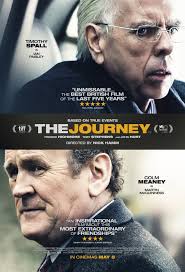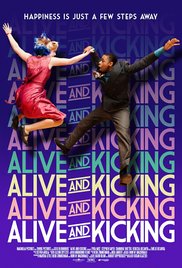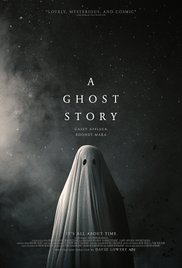 Nick Hamm directed “The Journey,” an imagined story about real events. Two bitter enemies, Protestant Ian Paisley (played by Timothy Spall) and Catholic Martin McGuinness (played by Colm Meaney), the bitterest of enemies, unwilling even to sit in the same room, managed to do what no one else had done for decades — to find a way to create peace in Northern Ireland after years of bloody battles. In real life, it took years. In the movie, time is compressed into one ride to the airport, shared by the two men and listened in on by a small group of very anxious government officials. But the spirit and even the language of the film accurately conveys the enormity of the situation and the statesmanship of the two men who discovered that no religion or political dispute could justify the terrible losses of The Troubles. In an interview, Hamm talked about the film’s relevance to today’s hyper-partisan conflicts around the world.
Nick Hamm directed “The Journey,” an imagined story about real events. Two bitter enemies, Protestant Ian Paisley (played by Timothy Spall) and Catholic Martin McGuinness (played by Colm Meaney), the bitterest of enemies, unwilling even to sit in the same room, managed to do what no one else had done for decades — to find a way to create peace in Northern Ireland after years of bloody battles. In real life, it took years. In the movie, time is compressed into one ride to the airport, shared by the two men and listened in on by a small group of very anxious government officials. But the spirit and even the language of the film accurately conveys the enormity of the situation and the statesmanship of the two men who discovered that no religion or political dispute could justify the terrible losses of The Troubles. In an interview, Hamm talked about the film’s relevance to today’s hyper-partisan conflicts around the world.
How do you find a balance between the familiar characteristics of these very well-known men and creating real characters?
We wanted to make it as accurate as possible. Both were well known but Paisley was a pretty iconic figure in English political life, known quite widely. The conflict ran for 34 years in Ireland. McGuinness in the later years of his career should we say was very public you know so people knew who they were. It was incumbent on us not to imitate but to get under the skin of them and I think that’s what Tim and Colm really do. Tim one of those extraordinary actors who melds into the character and he becomes and his kind of extremely fascinating process that we all went through. Tim is a 5 foot 8 inch Englishman playing this six foot massive Irish guy. But when we first showed it in Ireland, people thought he was completely bang on with Paisley. We had to make this people real because what you’re watching is the nuance of human behavior. You’ve taken away the normal activities that politicians deal with on a daily basis. You’ve removed the ability to speak to the media, to have an assistant, to deal with Congress, to be in a public situation, and you put them in a private situation. You strip from them all of that then is about how they deal with the domesticity of that situation, as though we are in the back of the car with them.
It all feels sadly timely with the way we see sharp and angry political divisions around the world.
Spot on. That is what we are talking about here. We are talking about two people in real life who came together and reached out beyond their base, beyond their own constituency and risked sacrificing their own political life for the betterment of other people. That really happened and their relationship opened the door into the Northern Island peace process which really stopped people killing each other. This was not a fictionalized event. This happened. It was real and the bombing stopped, and in that sense it is a great political story. It is a unique political story.
All over we see a climate of intransigence, tribal loyalties and politicians just appealing to their base. The left is as bad as the right. There’s no condemnation of either side. They both are as bad. Both sides looks for constant reaffirmation from social media, constantly feeling that only they know the way forward, and that is the way of madness. And it’s weird how it’s grown. So the argument of the movie is: now more than ever you need leaders who can take their base and can take their constituents and can move and reach out across that divide and actually do something. We need politicians who can do that now.
So yes, it is a message but we didn’t start like that. We just started by telling this story to celebrate what they’d actually achieved. And it was in the most extreme circumstances. It takes a huge amount of magnanimity to be able to to have your political beliefs and then just understanding that other people have different perspectives. There’s no such thing as political absolute truth. Your version of a blue sky is different from my version of blue sky. There’s no society in the history of the world, in the history of civilization, in which absolute truth has survived and existed and people ascribe to it.
I went to see McGuinness before we started shooting and talked to him for a couple of hours. He talked about his relationships with the IRA and the British government and he talked about one particular journey that they took, because politicians from Northern Ireland were travelling together for years and then denying the fact that they were on the same plane, even getting off the plane at separate times so that people wouldn’t see them laughing together, wouldn’t see them talking together. Did you know at the peace talks neither party sat in the same room? I find that the most extraordinary thing. You had flown to Scotland, the British government is putting you up, you’re staying in the same hotel, but you wouldn’t even eat in the same bloody restaurant and you won’t meet in the damn room together. So when Paisley actually said he was going to fly back the British government put him on a plane and and McGuinness went with them and that was the first time that they actually started to acknowledge each other. McGuinness said that Paisley had never even acknowledged his existence before that. Two days later I talked to Paisley’s son, and he was on the plane, and he even took some film of it, but his story was completely different. And that was when I knew that no one has the truth entirely.
This week, the British Embassy in Washington is putting on a screening at the institute for Peace
I think a lot of Congressmen and Senators are coming and senators. I think it will be fascinating to see. We actually had it in the House of Commons and here we are debating a film about the nature of terror a hundred feet from wher a week later all the flowers would be piled up for the death of the policeman being stabbed and here I am in two days time going to Washington to show the movie to members of Congress and you had that terrible atrocity just happen there. It seems like a lot to ask of a movie but I hope somehow we can be a reminder of what is possible if people find that what they have in common is more important than their differences.



 Nick Hamm directed “The Journey,” an imagined story about real events. Two bitter enemies, Protestant Ian Paisley (played by Timothy Spall) and Catholic Martin McGuinness (played by Colm Meaney), the bitterest of enemies, unwilling even to sit in the same room, managed to do what no one else had done for decades — to find a way to create peace in Northern Ireland after years of bloody battles. In real life, it took years. In the movie, time is compressed into one ride to the airport, shared by the two men and listened in on by a small group of very anxious government officials. But the spirit and even the language of the film accurately conveys the enormity of the situation and the statesmanship of the two men who discovered that no religion or political dispute could justify the terrible losses of The Troubles. In an interview, Hamm talked about the film’s relevance to today’s hyper-partisan conflicts around the world.
Nick Hamm directed “The Journey,” an imagined story about real events. Two bitter enemies, Protestant Ian Paisley (played by Timothy Spall) and Catholic Martin McGuinness (played by Colm Meaney), the bitterest of enemies, unwilling even to sit in the same room, managed to do what no one else had done for decades — to find a way to create peace in Northern Ireland after years of bloody battles. In real life, it took years. In the movie, time is compressed into one ride to the airport, shared by the two men and listened in on by a small group of very anxious government officials. But the spirit and even the language of the film accurately conveys the enormity of the situation and the statesmanship of the two men who discovered that no religion or political dispute could justify the terrible losses of The Troubles. In an interview, Hamm talked about the film’s relevance to today’s hyper-partisan conflicts around the world.